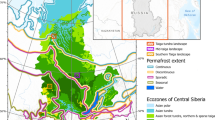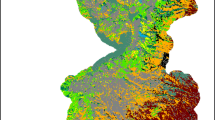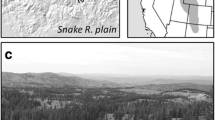Abstract
Dynamic relationships among climate, disturbance, and vegetation affect the spatial configuration and composition of ecological communities. Paleoecological records indicate the importance of such relationships in Minnesota’s Big Woods (BW) region, where isolated hardwood forest populations expanded to regional dominance after AD 1250. We used LANDIS-II to model the BW forest expansion, and conducted simulation experiments that isolated the important ecological factors in this regional change. In our simulations, BW forest expanded at approximately 15 m per year to achieve regional dominance within 600 years, which is comparable to empirical records. The distribution of the BW depended on the locations of scattered pre-existing tree populations that were sheltered from previous severe fire regimes by firebreaks. During the simulated spread of the tree populations, however, the presence or absence of firebreaks did not further influence vegetation pattern. When we assumed a fire rotation of 10–13 years in grasslands/woodlands and more than 400 years in BW, the feedback between fire-resistant BW fuels and fire severity caused fire severity to decline in a time frame consistent with sedimentary data. In our simulations, seed dispersal from core initial populations caused forest expansion, changed fuel loads, and thus reduced fire severity—not the other way around as has been commonly proposed. Forest expansion was slowed by fire, but species’ life history attributes, namely seed dispersal distances and maturity ages, asynchronous successional dynamics across many stands, and landscape history were at least as important in the temporal and spatial patterns of the regional response to climate change.







Similar content being viewed by others
References
Anfinson SF. 1989. Archaeology of the central Minneapolis riverfront, part 1: historical overview and archaeological potentials. The Minnesota Archaeologist 48:1–160.
Bond WJ, Woodward FI, Midgley GF. 2005. The global distribution of ecosystems in a world without fire. New Phytol 165:525–38.
Bradshaw RHW, Webb TIII. 1985. Relationships between contemporary pollen and vegetation data from Wisconsin and Michigan, USA. Ecology 66:721–37.
Brugam RB, Swain P. 2000. Diatom indicators of peatland development at Pogonia Bog Pond, Minnesota. Holocene 10:453–64.
Burns RM, Honkala BH. 1990. Silvics of North America. Washington (DC): USDA Forest Service.
Camill P, Umbanhowar CE, Teed R, Geiss CE, Aldinger J, Dvorak L, Kenning J, Limmer J, Walkup K. 2003. Late-glacial and Holocene climatic effects on fire and vegetation dynamics at the prairie-forest ecotone in south-central Minnesota. J Ecol 91:822–36.
Chandler C, Cheney P, Thomas P, Trabaud L, Williams D. 1983. Fire in forestry, Vol. 1. Forest fire behavior and effects. New York: John Wiley & Sons. p 450.
Clark JS, Royall PD, Chumbley C. 1996. The role of fire during climate change in an eastern deciduous forest at Devil’s Bathtub, New York. Ecology 77:2148–66.
Clark JS, Fastie C, Hurtt G, Jackson ST, Johnson C, King GA, Lewis M, Lynch J, Pacala S, Prentice C, Schupp EW, Webb TIII, Wyckoff P. 1998. Reid’s paradox of rapid plant migration. Bioscience 48:13–24.
Clevenger AP, Wierzchowski J, Chruszcz B, Gunson K. 2002. GIS-generated, expert-based models for identifying wildlife habitat linkages and planning mitigation passages. Conserv Biol 16:503–14.
Cohen J. 1960. A coefficient of agreement for nominal scales. Educ Psychol Meas 20:37–46.
Curtis JT. 1971. The vegetation of Wisconsin: an ordination of plant communities. Madison (WI): University of Wisconsin Press. p 657.
Davis AM. 1977. The prairie-deciduous forest ecotone in the upper Middle West. Ann Assoc Am Geogr 67:204–13.
Davis MB. 1989. Lag in vegetation response to greenhouse warming. Clim Change 15:75–82.
Davis MB, Botkin DB. 1985. Sensitivity of cool-temperate forests and their fossil pollen record to rapid temperature change. Quat Res 23:327–40.
Denevan WM. 1992. The pristine myth: the landscape of the Americas in 1492. Ann Assoc Am Geogr 82:369–85.
Dobrowski SZ. 2011. A climatic basis for microrefugia: the influence of terrain on climate. Glob Change Biol 17:1022–35.
Foster DF, Swanson F, Aber J, Burke I, Brokaw N, Tilman D, Knapp A. 2003. The importance of land-use legacies to ecology and conservation. Bioscience 53:77–88.
Gajewski K. 1988. Late Holocene climate changes in eastern North America estimated from pollen data. Quat Res 29:255–62.
Green DG. 1982. Fire and stability in the postglacial forests of southwest Nova Scotia. J Biogeogr 9:29–40.
Grimm EC. 1983. Chronology and dynamics of vegetation change in the prairie-woodland region of southern Minnesota, U.S.A. New Phytol 93:311–50. Data archived at the World Data Center for Paleoclimatology, Boulder, CO.
Grimm EC. 1984. Fire and other factors controlling the Big Woods vegetation of Minnesota in the mid-nineteenth century. Ecol Monogr 54:291–311.
Grimm V, Revilla E, Berger U, Jeltsch F, Mooij WM, Railsback SF, Thulke HH, Weiner J, Wiegand T, DeAngelis DL. 2005. Pattern-oriented modeling of agent-based complex systems: lessons from ecology. Science 310:987–91.
Hirsch KG. 1996. Canadian forest fire behavior prediction system: user’s guide. Vancouver: University of British Columbia Press. p 122.
Lloyd AH. 2005. Ecological histories from Alaskan tree lines provide insight into future change. Ecology 86:1687–95.
Lynch EA. 1998. Origin of a park-forest vegetation mosaic in the Wind River Range, Wyoming. Ecology 79:1320–38.
Maenza-Gmelch TE. 1997. Holocene vegetation, climate, and fire history of the Hudson Highlands, southeastern New York, USA. Holocene 7:25–37.
Marschner FJ. 1974. The original vegetation of Minnesota (map). Saint Paul (MN): United States Forest Service, North Central Forest Experiment Station.
McAndrews JH. 1968. Pollen evidence for the protohistoric development of the “Big Woods” in Minnesota (U.S.A.). Rev Palaeobot Palynol 7:201–11.
McLachlan JS, Clark JS. 2004. Reconstructing historical ranges with fossil data at continental scales. For Ecol Manag 197:139–47.
McLachlan JS, Clark JS, Manos PS. 2005. Molecular indicators of tree migration capacity under rapid climate change. Ecology 86:2088–98.
Mladenoff DJ. 2004. LANDIS and forest landscape models. Ecol Model 180:7–19.
Mladenoff DJ, He HS. 1999. Design, behavior and application of LANDIS, an object oriented model of forest landscape disturbance and succession. In: Mladenoff DJ, Baker WL, Eds. Spatial modeling of forest landscape change: approaches and applications. Cambridge: Cambridge University Press. pp 125–62.
Monserud RA, Leemans R. 1992. Comparing global vegetation maps with the Kappa statistic. Ecol Model 62:275–93.
Nelson DM, Hu FS, Tian J, Stefanova I, Brown TA. 2004. Response of C3 and C4 plants to middle-Holocene climatic variation near the prairie-forest ecotone of Minnesota. Proc Natl Acad Sci 101:562–7.
Overpeck JT, Rind D, Goldberg R. 1990. Climate-induced changes in forest disturbance and vegetation. Nature 343:51–3.
Perala DA. 1974. Growth and survival of northern hardwood sprouts after burning. U.S. Forest Service Research Note NC-176.
Peteet D. 2000. Sensitivity and rapidity of vegetational response to abrupt climate change. Proc Natl Acad Sci 97:1359–61.
Prentice IC, Cramer W, Harrison SP, Leemans R, Monserud RA, Solomon AM. 1992. A global biome model based on plant physiology and dominance, soil properties and climate. J Biogeogr 19:117–34.
Sauer CO. 1950. Grassland climax, fire, and man. J Range Manag 3:16–21.
Scheller RM, Mladenoff DJ. 2005. A spatially interactive simulation of climate change, harvesting, wind, and tree species migration and projected changes to forest composition and biomass in northern Wisconsin, USA. Glob Change Biol 11:307–21.
Scheller RM, Domingo JB, Sturtevant BR, Williams JS, Rudy A, Gustafson EJ, Mladenoff DJ. 2007. Design, development, and application of LANDIS-II, a spatial landscape simulation model with flexible temporal and spatial resolution. Ecol Model 201:409–19.
Shuman B, Henderson AK, Plank C, Stefanova I, Ziegler SS. 2009. Woodland-to-forest transition during prolonged drought in Minnesota after ca. AD 1300. Ecology 90:2792–807.
Sturtevant BR, Gustafson EJ, Li W, He HS. 2004. Modeling biological disturbances in LANDIS: a module description and demonstration using spruce budworm. Ecol Model 180:153–74.
Sturtevant BR, Miranda BR, Yan J, He HS, Gustafson EJ, Scheller RM. 2009a. Studying fire mitigation strategies in multi-ownership landscapes: balancing the management of fire-dependent ecosystems and fire risk. Ecosystems 12:445–61.
Sturtevant BR, Scheller RM, Miranda BR, Shinneman D, Syphard A. 2009b. Simulating dynamic and mixed-severity fire regimes: a process-based fire extension for LANDIS-II. Ecol Model 220:3380–93.
Sugita S. 1994. Pollen representation of vegetation in quaternary sediments: theory and method in patchy vegetation. J Ecol 82:881–97.
Syphard AD, Clarke KC, Franklin J. 2007. Simulating fire frequency and urban growth in southern California coastal shrublands, USA. Landscape Ecol 22:431–45.
Tilman D, Reich P, Phillips H, Menton H, Patel A, Vos E, Peterson D, Knops J. 2000. Fire suppression and ecosystem carbon storage. Ecology 81:2680–5.
Tinner W, Lotter AF. 2001. Central European vegetation response to abrupt climate change at 8.2 ka. Geology 29:551–4.
Umbanhowar CE. 2004. Interaction of fire, climate and vegetation change at a large landscape scale in the Big Woods of Minnesota, USA. Holocene 14:661–76.
Umbanhowar CE, Camill P, Geiss CE, Teed R. 2006. Asymmetric vegetation responses to mid-Holocene aridity at the prairie-forest ecotone in south-central Minnesota. Quat Res 66:53–66.
USDA Forest Service, Rocky Mountain Research Station, Fire Sciences Laboratory. Fire Effects Information System. http://www.fs.fed.us/database/feis/. Accessed 9/10/2007.
Vale TR. 2002. The pre-European landscape of the United States: Pristine or humanized? In: Vale TR, Ed. Fire, native peoples, and the natural landscape. Washington (DC): Island Press. pp 1–40.
Ward BC, Scheller RM, Mladenoff DJ. 2004. Technical report: LANDIS-II double exponential seed dispersal algorithm. Madison (WI): University of Wisconsin.
Webb TIII. 1986. Is vegetation in equilibrium with climate? How to interpret late-Quaternary pollen data. Vegetatio 67:75–91.
Williams JW, Post DM, Cwynar LC, Lotter AF, Levesque AJ. 2002. Rapid and widespread vegetation responses to past climate change in the North Atlantic region. Geology 30:971–4.
Wimberly MC. 2004. Fire and forest landscapes in the Georgia Peidmont: an assessment of spatial modeling assumptions. Ecol Model 180:41–56.
Acknowledgments
This work was supported by University of Minnesota McKnight Land-Grant Professorships held by Shuman and Manson, and a University of Minnesota Department of Geography fellowship held by Berland. We thank Rebecca Montgomery for discussions of the material presented here, and David Mladenoff, Brian Sturtevant, Brian Miranda, and Robert Scheller for LANDIS-II discussions and information. We also thank two anonymous reviewers for helpful comments on the manuscript.
Author information
Authors and Affiliations
Corresponding author
Additional information
Author Contributions
AB, BS, and SMM designed the study; AB performed research; AB and BS analyzed data; AB, BS, and SMM wrote the paper.
Rights and permissions
About this article
Cite this article
Berland, A., Shuman, B. & Manson, S.M. Simulated Importance of Dispersal, Disturbance, and Landscape History in Long-Term Ecosystem Change in the Big Woods of Minnesota. Ecosystems 14, 398–414 (2011). https://doi.org/10.1007/s10021-011-9418-x
Received:
Accepted:
Published:
Issue Date:
DOI: https://doi.org/10.1007/s10021-011-9418-x




